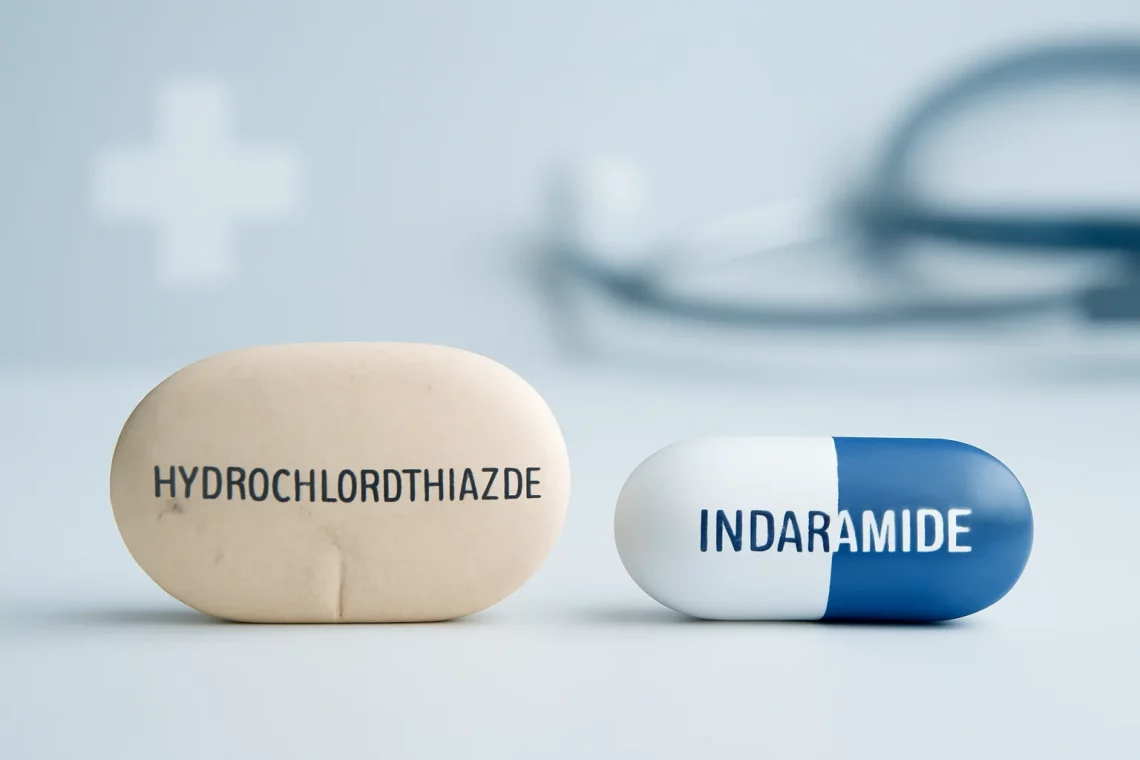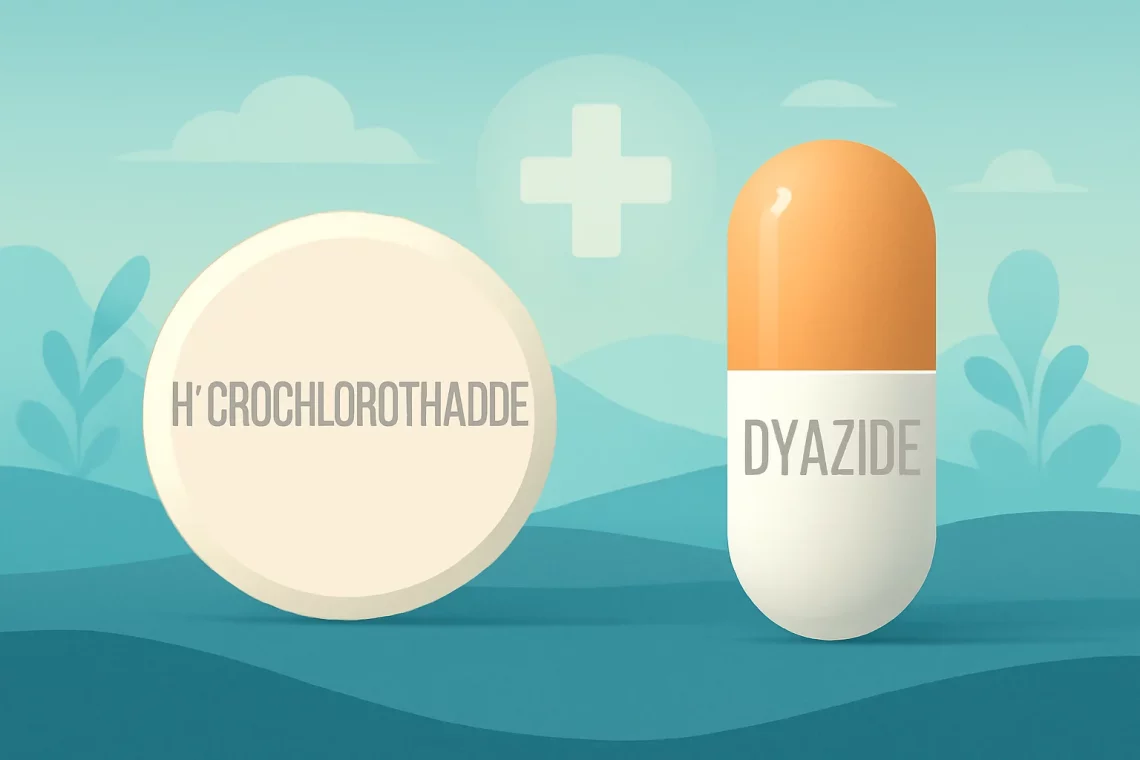-
Valsartan vs Losartan: Which Blood Pressure Medication is Right for You?
High blood pressure, also known as hypertension, is a common health issue affecting millions of people worldwide. It often goes unnoticed as it typically does not present any symptoms, which is why it is often referred to as a “silent killer.” Managing hypertension is crucial as it can lead to serious complications such as heart disease, stroke, and kidney failure. To combat this condition, healthcare providers often prescribe medications known as antihypertensives. Among the various options available, two widely used medications are Valsartan and Losartan. Both belong to a class of drugs called angiotensin receptor blockers (ARBs) and are effective in lowering blood pressure by relaxing blood vessels. However, despite…
-
Hydrochlorothiazide vs Indapamide: Key Differences Explained
High blood pressure, also known as hypertension, is a prevalent health condition affecting millions of individuals worldwide. Often dubbed the “silent killer,” hypertension can lead to serious health complications if not managed properly. As such, effective management of blood pressure is crucial for maintaining overall health and preventing associated risks such as heart disease, stroke, and kidney problems. Among the various treatment options available, both hydrochlorothiazide and indapamide stand out as commonly prescribed diuretics. These medications play a significant role in helping patients regulate their blood pressure levels while also contributing to fluid balance in the body. Understanding the differences and similarities between hydrochlorothiazide and indapamide can be vital for…
-
Amlodipine vs Cardizem: Comparing Two Common Blood Pressure Medications
Amlodipine and Cardizem are two commonly prescribed medications used to manage hypertension and certain types of angina. Both belong to a class of drugs known as calcium channel blockers, which work by relaxing the blood vessels to allow for easier blood flow. Over the years, these medications have gained popularity due to their effectiveness in controlling blood pressure and alleviating chest pain associated with heart conditions. While both Amlodipine and Cardizem serve similar purposes, they have distinct differences that can influence a doctor’s choice when prescribing them. Factors such as the patient’s medical history, specific health conditions, and potential side effects play a crucial role in determining which medication may…
-
Dexmethylphenidate vs Methylphenidate: Key Differences Explained
Dexmethylphenidate and methylphenidate are two medications commonly used to treat attention deficit hyperactivity disorder (ADHD) and narcolepsy. Both drugs belong to the class of stimulants and are known for their ability to enhance focus, attention, and impulse control. While they share many similarities in terms of their mechanisms of action, chemical structures, and therapeutic uses, there are key differences that can influence a physician’s choice between the two. Understanding these differences is crucial for patients, caregivers, and healthcare providers alike. The popularity of these medications has surged in recent years, leading to increased awareness and discussions around their efficacy, potential side effects, and the implications of their use. As mental…
-
Loratadine vs Claritin: Key Differences You Should Know
Loratadine and Claritin are terms often used interchangeably in discussions regarding the management of allergy symptoms. For many, particularly those suffering from seasonal allergies or allergic rhinitis, understanding the nuances between these two names can be critical in making informed decisions about their health. As a second-generation antihistamine, loratadine has gained popularity for its effectiveness in alleviating allergy-related symptoms such as sneezing, runny nose, and itchy eyes. However, Claritin, which is a brand name for loratadine, has also carved out a significant place in the market, leading to some confusion among consumers about their differences. The landscape of allergy medications is vast, with countless options available that promise relief from…
-
Hydrochlorothiazide vs Dyazide: Key Differences and Uses Explained
Hydrochlorothiazide and Dyazide are two medications often discussed in the context of managing hypertension and fluid retention. Both of these drugs belong to the class of thiazide diuretics, which are commonly prescribed for lowering blood pressure and reducing excess fluid in the body. While they share some similarities, they also possess distinct characteristics that can influence a healthcare provider’s choice when determining the most appropriate treatment for a patient. Understanding the nuances between Hydrochlorothiazide and Dyazide can be beneficial for patients, caregivers, and healthcare professionals alike. The choice of medication can depend on various factors, including the patient’s overall health, specific medical conditions, and the presence of other medications. Furthermore,…
-
Cyclobenzaprine vs Robaxin: Key Differences and Uses Explained
Cyclobenzaprine and Robaxin are two commonly prescribed muscle relaxants that are used to alleviate muscle spasms and discomfort caused by musculoskeletal conditions. As patients seek effective relief from pain and tension, understanding the differences between these medications becomes crucial. Both drugs belong to different classes of muscle relaxants and have unique mechanisms of action, side effects, and potential interactions. Cyclobenzaprine is often utilized for short-term treatment of muscle spasms, providing quick relief for patients who are recovering from injuries or dealing with acute pain. Its sedative properties can be beneficial in promoting rest, but they also raise considerations regarding daytime drowsiness and impairment. On the other hand, Robaxin, or methocarbamol,…
-
Naproxen vs Aleve: Understanding Their Uses and Differences
Naproxen and Aleve are two commonly used medications that belong to a class of drugs known as nonsteroidal anti-inflammatory drugs (NSAIDs). These medications are widely utilized for their analgesic and anti-inflammatory properties, making them effective for treating various conditions such as arthritis, muscle pain, menstrual cramps, and other types of pain. The popularity of both Naproxen and Aleve can be attributed to their efficacy in providing relief from discomfort while also reducing inflammation. Understanding the differences and similarities between Naproxen and Aleve can be crucial for individuals seeking the most suitable option for their pain management needs. While both medications offer similar benefits, they also have unique characteristics that may…
-
Azithromycin vs Augmentin: Key Differences and Uses Explained
In recent years, the landscape of medicine has evolved significantly, particularly in the realm of antibiotics. Among the many bacterial infections that affect millions worldwide, the choice of antibiotic can be critical. Two commonly prescribed antibiotics are Azithromycin and Augmentin. Each of these medications has its own unique properties, uses, and mechanisms of action, leading healthcare professionals to make informed decisions when prescribing them. Understanding the differences between these two antibiotics is essential for both patients and practitioners. Factors such as the type of infection, bacterial resistance, and patient history can influence which antibiotic will be most effective. Furthermore, the rise of antibiotic resistance has made it increasingly important to…
-
Prednisone vs Kenalog: Key Differences and Uses Explained
Prednisone and Kenalog are two medications often utilized for their anti-inflammatory and immunosuppressive properties. While both drugs can be effective in treating a variety of conditions, they differ significantly in their composition, mechanisms of action, and the specific situations in which they are used. Understanding these differences is crucial for patients and healthcare providers alike, as it can significantly influence treatment decisions. Prednisone is a synthetic corticosteroid that mimics the effects of cortisol, a hormone produced by the adrenal glands. It is widely prescribed for conditions such as asthma, allergies, arthritis, and autoimmune diseases due to its ability to reduce inflammation and suppress the immune system. On the other hand,…







































